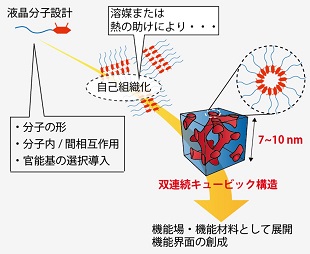液晶の自己組織化を利用した双連続キュービック構造の創成とその機能化

メンバー: 一川尚広、大野弘幸
分野: 材料化学、複合化学、基礎化学
所属: 工学研究院
キーワード: 双連続キュービック液晶、ジャイロイド界面、自己組織化、イオン液体
研究概要

液晶分子を巧みに設計すると、その熱的挙動または溶媒中での挙動をプログラムすることができます。これらの液晶材料は、近年、ソフトマテリアルの開発において注目されている自己組織性材料群の一種です。
我々は、この液晶分子が自己組織的に形成する集合構造の中でも双連続キュービック液晶(上図)に特に注力して研究を進めています。双連続キュービック構造は三次元的に連続的なチャンネルドメイン(上図赤)とそれを取り巻く連続ドメイン(上図青)からなっており、その連続性ゆえの特性を発揮します。また、ナノレベルで精緻な構造であるため、ナノスケール由来の特性発現も期待できます。
この双連続キュービック液晶は液晶材料の中でも珍しい液晶相であり、この液晶材料を「如何に設計するか」及び「その機能をデザインするか」が重要な課題と考えています。
具体的には以下の研究に取り組んでいます。
1) イオン液体設計を駆使した双連続キュービック液晶の開発
2) 双連続キュービック構造を利用した高速プロトン伝導界面の創成
3) ゲスト分子機能場としての双連続キュービック液晶の利用
主要論文・参考事項
[1] T. Ichikawa, M. Yoshio, A. Hamasaki, J. Kagimoto, H. Ohno, T. Kato, J. Am. Chem. Soc., 133, 2163 (2011). [DOI:10.1021/ja106707z]
[2] S. Ueda, J. Kagimoto, T. Ichikawa, T. Kato, H. Ohno, Adv. Mater., 23, 3071 (2011). [DOI:10.1002/adma.201100942]
[3] T. Ichikawa, T. Kato, H. Ohno, J. Am. Chem. Soc., 134, 11354 (2012). [DOI:10.1021/ja304124w]
[4] T. Ichikawa, K. Fujimura, M. Yoshio, T. Kato, H. Ohno, Chem. Commun., 49, 11746 (2013). [DOI:10.1039/c3cc45429k]
[5] T. Matsumoto, T. Ichikawa, J. Sakuda, T. Kato, H. Ohno, Bull. Chem. Soc. Jpn., 87, 792 (2014). [DOI:10.1246/bcsj.20140049]
お問い合わせ先
東京農工大学・先端産学連携研究推進センター
urac[at]ml.tuat.ac.jp([at]を@に変換してください)
Development of Bicontinuous Cubic Structures Through the Self-Organization of Liquid Crystals

Research members: Dr. Takahiro Ichikawa, Dr. Hiroyuki Ohno
Research fields: Materials chemistry, Applied chemistry, Basic chemistry
Departments: Institute of Engineering
Keywords: Bicontinuous cubic liquid crystal, Gyroid minimal surface, Self-organization, Ionic liquid
Summary

Self-organization of liquid crystals provides well-ordered and highly-defined nanostructures, and therefore they have attracted increasing attention in the field of the development of next-generation soft materials.
Among various liquid-crystalline materials, we have focused on bicontinuous cubic liquid crystals with expecting thier three-dimensionally continuous nanostructures. As shown in figure above, bicontinuous cubic structures are composed of three-dinmensionally interwoven nanochannel domains and a surrounding sheath domain. Owing to thier continuous stuructures, their application for nanostructured materials are now strongly expected.
Here we list our recent researches on the application of bicontinuous cubic liquid crystals.
1) Development of Bicontinuous Cubic Liquid Crystals by Using Ionic Liquids as Building Block
2) Creation of 3D Continuous Proton Conduction Surface
3) Application of Bicontinuous Cubic Liquid Crystals for Function Fields for Guest Molecules
Reference articles and patents
[1] T. Ichikawa, M. Yoshio, A. Hamasaki, J. Kagimoto, H. Ohno, T. Kato, J. Am. Chem. Soc., 133, 2163 (2011). [DOI:10.1021/ja106707z]
[2] S. Ueda, J. Kagimoto, T. Ichikawa, T. Kato, H. Ohno, Adv. Mater., 23, 3071 (2011). [DOI:10.1002/adma.201100942]
[3] T. Ichikawa, T. Kato, H. Ohno, J. Am. Chem. Soc., 134, 11354 (2012). [DOI:10.1021/ja304124w]
[4] T. Ichikawa, K. Fujimura, M. Yoshio, T. Kato, H. Ohno, Chem. Commun., 49, 11746 (2013). [DOI:10.1039/c3cc45429k]
[5] T. Matsumoto, T. Ichikawa, J. Sakuda, T. Kato, H. Ohno, Bull. Chem. Soc. Jpn., 87, 792 (2014). [DOI:10.1246/bcsj.20140049]
Contact
University Research Administration Center(URAC),
Tokyo University of Agriculture andTechnology
urac[at]ml.tuat.ac.jp
(Please replace [at] with @.)

